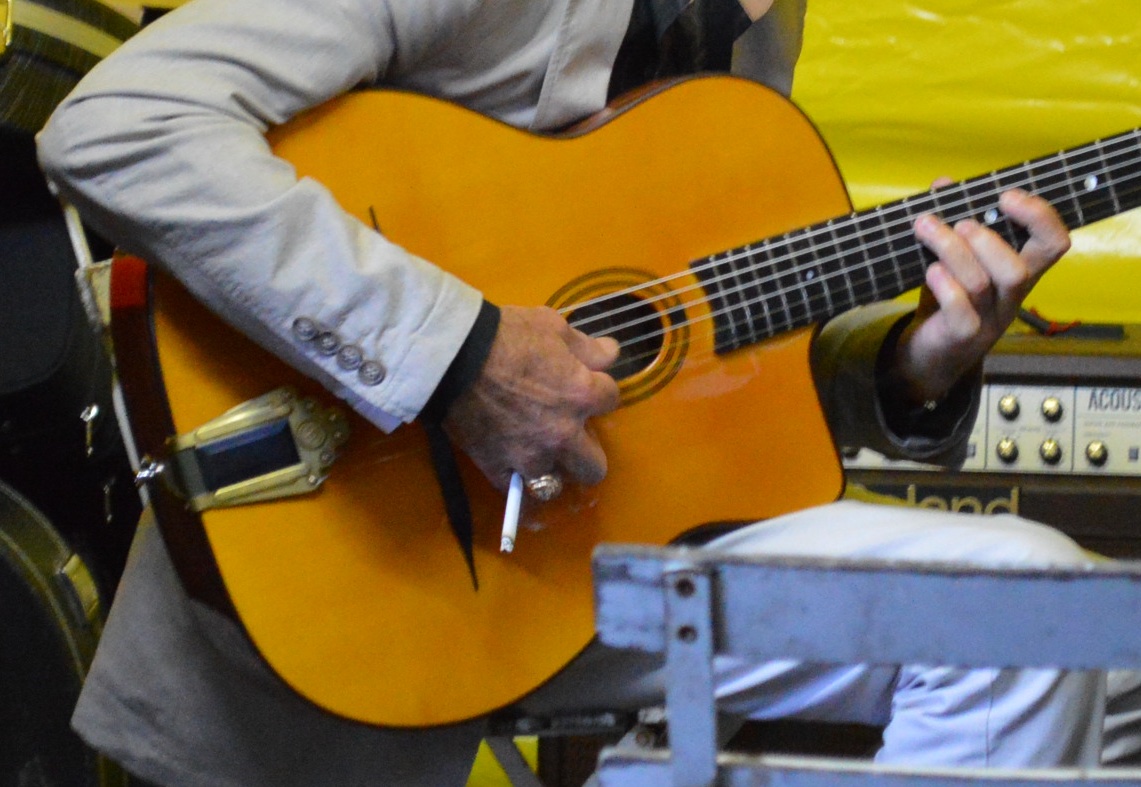Media: Chapter 4
Chapter 4, “The Sound of Feeling,” delves further into the subjective experience of ethnoracial identity to examine how difference is naturalized through language about instrumental sound. In talk about the sensory impressions made by jazz manouche guitar performance, speakers invoke qualities such as rawness, loudness, and “feeling” to describe both the sound itself and the person producing it as palpably Manouche. In doing so, they render Manouche identity a perceptible sensation, like the adjacent qualities used to describe it. I argue that claims about the indescribability of a uniquely Manouche sound constitute an effective strategy for conveying affective intensity. I propose the term ethnoracialness to account for the sensorial dimensions and often ineffable character of ethnoracial identity, as well as the ambiguity of ethnoracial differences as inherited and/or enculturated. A focus on how people claim to hear identity reveals continuities between individual sonic perceptions of, and broader semiotic ideologies about, ethnorace.
Image 4.0: Close-up of Angelo Debarre on guitar. Festival Django Reinhardt, Samois-sur-Seine, 2013. Photo by Siv B. Lie.

“In one blow he will tear you apart” (pp. 128-9)
In the chapter’s opening, I recount Cédric Loeffler’s vivid description of the feeling he gets when hearing Tchavolo Schmitt’s guitar soloing. The first video below, a performance of “Mire Pral,” is described on p. 129. The second video, a live performance at a music festival, features Tchavolo soloing over a blues progression.
Video 4.1: "Mire Pral," by Tchavolo Schmitt and Mandino Reinhardt. L to R: Mandino Reinhardt (guitar), Tchavolo Schmitt (guitar), Gautier Laurent (double bass), Sony Reinhardt (guitar).
Video 4.2: Tchavolo Schmitt leads a blues at the Fête à Neu Neu, Paris, 22 September 2013. L to R: Yorgui Loeffler, Sébastien Kauffmann, Tchavolo Schmitt, Claudius Dupont (bass), Steeve Laffont, Billy Weiss. Note that, in addition to his brazen soloing styles, Tchavolo exerts another kind of power: he gives the other instrumentalists very little information about the tune he is embarking on, teasingly forcing them to figure out amongst themselves, in the moment of performance, how to accompany him. Video by Siv B. Lie.
The Poetics of Ineffability and “Feeling” (pp. 134-8)
Audio example 4.1: "Anniversary Song" (pp. 134-5)
Composed by Ion Ivanovici as "Waves of the Danube," arranged by Al Jolson and Saul Chaplin. Performed by Django Reinhardt and the Quintette du Hot Club de France with Hubert Rostaing on clarinet, 6 July 1947, Paris.
Audio example 4.2: "Nuages" (p. 136)
Composed by Django Reinhardt. Performed by Django Reinhardt and the Quintette du Hot Club de France, 13 December 1940, Paris.
The Manouche blues (pp. 138-40)
Audio example 4.3: “Tangi Undercover” by Baro Syntax (p. 138) is a hop hop track that incorporates a riff from the opening of the original Django Reinhardt recording of “Minor Swing.” The title is a verlan-ization of Gitan, and the lyrics intersperse French and Romani languages.
Provincializing ethnoracialness (pp. 142-5)
The two brief instructional videos below come from DC Music School, run by guitarist Denis Chang (p. 223n31). I am including these videos both so that you can try to listen for any sonic differences between players who represent, generally, Alsace and Paris, and importantly, so that you can hear how each talks about distinct techniques and the relationship between the rhythm player and the soloist.
Video 4.3: First, listen to Hono Winterstein, mentioned as one exemplar of the “punch”-y Alsatian sound (pp. 143-4), describe various techniques for playing la pompe. This energy is most obvious in his demonstrations of “I Can’t Give You Anything But Love” near the beginning of the video and at 6m34s when he demonstrates “Hungaria.” (Note that Chang has some fun with his subtitling at the beginning!)
Video 4.4: Compare video 4.3 to Adrien Moignard, sometimes described as a foil to the more rustic Alsatian sound (pp. 141-2, 148), though this characterization is perhaps less clearly applicable in the context of his pompe (as opposed to his soloing technique). Note that there are several instances that are not included in the English subtitles in which he tells the viewer to adapt their rhythm styles to the “feeling” of the person one is playing with.
Video 4.5: Another example of the Alsatian sound is indicated on p. 223, note 30, in reference to p. 144: Brady Winterstein’s version of “Them There Eyes.” (Unfortunately, the YouTube link indicated in the book is no longer valid, but this video duplicates the same recording.)